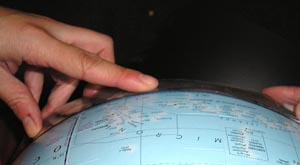
A strip of plastic is a scale model for the thickness of the Atmosphere.
Atmosphere Scale Model
It's a gas

A strip of plastic is a scale model for the thickness of the
Atmosphere.
Introduction
While the atmosphere is thick when compared with the height of a person it is thin compared to the radius of the earth. A strip of plastic can be used together with an earth globe to show the thickness of the atmosphere.
Material
Assembly
Measure the diameter of your earth globe.
Ours is 35 cm in diameter, and so 17.5 cm in radius.
Cut the top off of the PET bottle using the knife.
Use the scissors to cut two rings about 2.5 cm wide around the circumference of the bottle .
Cut the rings to make two strips. Each of these strips will be about 0.3 mm thick.
Glue the two strips on top of each other to make one strip 0.6 mm thick.
Optional Assembly
Cut a ring out of the peanut butter jar, it will be about 0.6 mm thick.
To Do and Notice
Lay the stip along the equator of the earth.

The plastic is placed along the equator.
At this scale, 90% of the atmosphere of the earth is within the thickness of the strip.
What's Going On?
Almost all of the atmosphere, 90%, is within 15 km of the surface of the earth.
Half of the atmosphere is within 5 km of the surface of the earth.
Go up another 5 km to 10 km and there is only 1/4 of the atmosphere remaining above you, 3/4 is below. This is the height at which many commercial jet aircraft fly.
Go up anothre 5 km to 15 km and only 1/8 of the atmosphere remains above you, you are over nearly 90% of the atmosphere at this altitude.
At the equator, the height of the troposphere is about 16 km, about the thickness of this strip.
The troposphere is the lowest region of the earth's atmosphere where the temperature decreases with increasing height.
Math Root
The pressure of the atmosphere is an exponential function of height.
That is, every time you add 5 km to your elevation above sea level the atmospheric pressure is cut in half.
Height km Pressure Bar 0 1 5 1/2 10 1/4 15 1/8
We are approximating here since the exact change in pressure also depends on the temperature, but this gives the main idea.
The equation for the pressure, P, is
P = Po 2 h/5km
Where Po is the atmospheric pressure at the surface.
and h is the height in km.
Notice that according to this equation the pressure never goes to zero, it gets smaller and smaller. So this equation cannot be used to define the top of the atmosphere.
|
Scientific Explorations with Paul Doherty |
|
21 November 2006 |